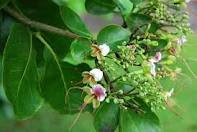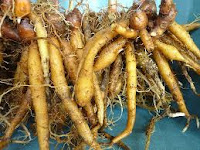FINGERROOT, KRA CHAI, BOESENBERGIA ROTUNDA
Fingerroot is used in
China only for its medicinal properties, whereas in
Thailand it is cultivated for culinary and medicinal purposes. It is a member of the Zingiberaceae family so is related to
ginger,
zedoary (
kachur) or white turmeric (
Curcuma zedoaria),
turmeric, and
kulanjan (
Alpinia galangal). It is also known as Chinese ginger, or Chinese keys, as the rhizome resembles keys on a key ring, with a globe at the top of the key-like roots or fingers which extrude from it.

It is also known as
Curcuma rotunda,
Gastrochilus rotundus and
Boesenbergia pandurata. It has a spicy flavour and is eaten in
Thailand as a vegetable and used as a spice. The plant can grow to 60 centimetres high and is located in its wild state in dense forests. However it is cultivated throughout south-east
Asia and has naturalized in many countries. The leaves are edible as is the root and rhizome, and medicinally it has been employed for many purposes in traditional medicine systems in
India,
Malaysia,
Indonesia and other countries. Its leaves are used with those of the
teak tree (
Tectona grandis) to wrap tempeh in. (Tempeh is the traditional fermented soya bean cake which is eaten in
Indonesia.)

In the West this plant is grown as an ornamental as it has attractive pink flowers and is aromatic. The finger-like roots are bright yellow and their aroma comes from the camphor, methyl cinnamate, d-borneol and 1-8 cineol mainly although there are also other aromatic substances in them.
The crushed roots and rhizomes are applied to painful parts of the body to ease rheumatic pains, and they are used internally to dispel flatulence, improve the appetite and digestion, as a remedy for dry mouths, coughs and ulcers. After giving birth a post-partum tonic is prepared from them and a paste may also be made from the roots and applied externally to the body after childbirth. The paste is also applied to piles and a lotion made from them is used for rheumatism, and muscle pains. They are also used for diarrhoea and dysentery.

In
Thailand they are used to increase male libido and are touted as being able to increase sperm and improve its quality. Tests carried out in vivo on male rats did not bear out these uses, but the rats’ testicles did increase in weight and size.
Scientific evidence suggests that the roots may have anticancer properties, and research is still underway on these properties. They are also believed to have analgesic (mild pain relieving) properties, as well as antibacterial, antifungal, antipyretic, anti-inflammatory, antispasmodic and insecticidal properties.
There have been investigations which suggest that the
flavonoids in the roots can prevent an occurrence of dengue fever (
Biorganic and Medicinal Chemistry Letters Vol. 16 (12) June 2006 pp.3337-40).

Its anti-ulcerogenic properties have also been tested and found to be supported (“The methanolic extract of
Boesenbergia rotunda (L) Mansf. and its major compound pinostrobin induces anti-ulcerogenic property in vivo: Possible involvement of indirect antioxidant action”, Siddiq I. Abdelwahab et al
. Journal of Ethnopharmacology, July 2011).
Its anti-cancer properties were documented in a study by Chandra Kirana et al in the Journal of Natural Medicine Vol. 61 (2007) pp. 131-137 “Anticancer properties of panduratin A isolated from Boesenbergia pandurata (Zingiberaceae)” which concluded with the statement that this “may have a protective effect against colon cancer” but it needed further investigation for this claim and to ascertain if it was effective against other types of cancer cells particularly those of breast cancer.

In 2011 Shiau-Chuen Cheah et al showed that the tests were valid in an article “Panduratin A Inhibits the Growth of A 549 Cells through Induction of Apoptosis and Inhibition of NF-KappaB Translocation” published in
Molecules, 2011 Vol.16 pp.2583-2598.
Research is still continuing into this Chinese medicinal herb.
 This plant is native to
This plant is native to  In
In  “Government and virtues. It is a hot and biting martial plant: brooklime and water-cresses are generally used together in diet-drinks, with other things serving to purge the blood and body from ill-humours that would destroy health, and are helpful for the scurvy: they do also provoke urine, and help to break the stone, and pass it away; they provoke women's courses, and expel the dead child. Being fried with butter and vinegar, and applied warm, it helpeth all manner of tumours, swellings, and inflammations.
“Government and virtues. It is a hot and biting martial plant: brooklime and water-cresses are generally used together in diet-drinks, with other things serving to purge the blood and body from ill-humours that would destroy health, and are helpful for the scurvy: they do also provoke urine, and help to break the stone, and pass it away; they provoke women's courses, and expel the dead child. Being fried with butter and vinegar, and applied warm, it helpeth all manner of tumours, swellings, and inflammations. 
















